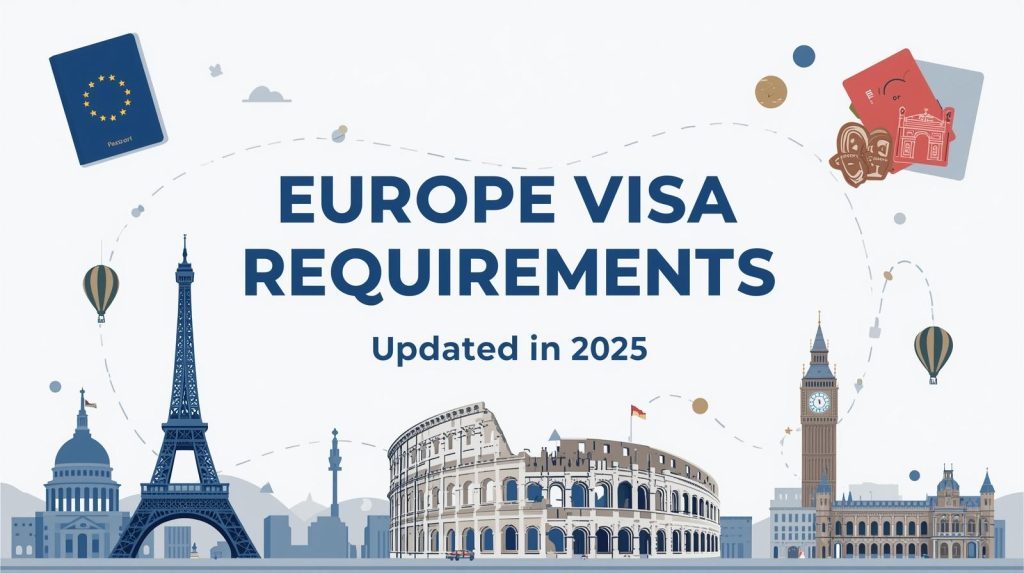Europe Visa Requirements (Updated) in 2025
Planning a trip to Europe? Understanding the visa requirements is essential for smooth travel. Whether you’re visiting for tourism, business, study or family visits, this guide breaks down everything you need to know in clear, simple language.

What Is a Schengen Visa?
Most popular destinations in Europe fall under the Schengen Area. This zone includes 27 countries that share border-free travel. A Schengen visa lets you travel freely within these countries for up to 90 days in a 180-day period. It’s ideal for short trips, multiple-country tours, or weekend getaways.
Who Needs a Schengen Visa?
Citizens of many non-EU countries must apply for a Schengen visa before arrival. Check if your nationality requires one:
- US, Canada, Australia, Japan and several others enjoy visa-free short stays up to 90 days.
- India, Pakistan, Nigeria and many African, Asian and Latin American countries need a visa in advance.
Always verify the latest list of visa-exempt countries on official embassy websites.
Types of Schengen Visas
- Tourist Visa – For sightseeing, holidays or family visits.
- Business Visa – For meetings, conferences, or short business trips.
- Transit Visa – For layovers and airport transfers within the Schengen zone.
- Family Visit Visa – For visiting relatives who live in a Schengen country.
- Student Visa (Short Stay) – For short courses or training up to 3 months.
Choosing the correct visa type ensures you avoid delays or rejections.
Basic Documents You Need
Most Schengen visa applications require a similar set of documents:
- Valid Passport
- Issued within last 10 years and valid for at least three months after planned departure.
- At least two blank pages.
- Completed Visa Application Form
- Fill in accurately and sign.
- Available online or at local consulate.
- Recent Passport Photos
- Two color photos.
- White background, 35×45 mm size.
- Travel Itinerary
- Flight reservations showing entry and exit dates.
- Hotel bookings or an invitation letter if staying with family/friends.
- Travel Insurance
- Coverage of at least €30,000 for medical emergencies and repatriation.
- Valid throughout the Schengen Area.
- Proof of Funds
- Bank statements for the last three months.
- Sponsorship letter if someone else covers costs.
- Cover Letter
- Brief statement explaining trip purpose, dates, and itinerary.
- Proof of Employment or Studies
- Employment: recent pay slips, leave approval letter.
- Students: university enrollment certificate and leave letter.
Additional Requirements for Specific Cases
- Self-Employed Applicants – Business registration, tax returns, bank statements.
- Minors – Birth certificate, parental consent, copies of parents’ passports.
- Retired Applicants – Pension statements or retirement documents.
Always check the specific embassy or consulate for extra requirements.
Step-by-Step Application Process
- Identify the Correct Consulate
- Apply at the consulate of the main destination country.
- If visiting multiple countries, choose the one where you spend the most days.
- Book an Appointment
- Online or by phone.
- Secure an early slot, especially during peak season.
- Gather Documents
- Prepare originals and photocopies.
- Organize in the order listed by the consulate.
- Attend the Interview
- Arrive 15 minutes early.
- Bring all documents and a printed appointment confirmation.
- Answer questions clearly and honestly.
- Pay the Visa Fee
- Usually around €80 for adults.
- Children under 12 pay a reduced fee of €40.
- Wait for Processing
- Standard processing time is 15 calendar days.
- It may take up to 30 days during busy periods.
- Collect Your Passport
- You will be notified by email or SMS.
- Check visa sticker details for accuracy.
Tips to Boost Approval Chances
- Apply Early – Two to three months before departure.
- Complete Documents – Missing papers are the top cause of rejections.
- Show Strong Ties – Job, family, property prove you will return home.
- Accurate Travel Plans – Booking rather than open-ended reservations.
- Clear Cover Letter – State purpose, duration and funding source convincingly.
Common Reasons for Visa Rejection
- Insufficient financial proof.
- Invalid or incomplete application form.
- Lack of travel insurance.
- Unclear travel itinerary.
- Previous overstays in the Schengen Area.
If rejected, the consulate will provide a reason. You can appeal or reapply after addressing issues.
Extending Your Schengen Stay
Extensions are granted only under exceptional circumstances, such as:
- Medical emergencies.
- Serious family issues.
- Force majeure events like natural disasters.
Apply at the immigration office in the Schengen country you’re in, at least two weeks before your visa expires.
Beyond Schengen: Other EU Visa Options
Some EU countries such as Bulgaria, Romania, Cyprus and Ireland are not fully Schengen participants. They have their own visa rules:
- Ireland – Single-country visa, valid only for Ireland, but a separate visa Waiver Program exists for US citizens.
- Bulgaria, Romania, Cyprus – Issue national visas. May require an additional border check for Schengen entry.
If your trip includes these countries, confirm requirements with the respective embassies.
After Arrival: Know the Rules
- 90/180-Day Rule – Maximum 90 days in any 180-day period in Schengen Area.
- Register Your Stay – Some countries require local police registration for stays over 90 days.
- Avoid Unauthorized Work – Schengen tourist visas prohibit paid work.
Final Thoughts
Understanding Europe visa requirements keeps your travel stress-free. Start early, prepare thoroughly, and follow each step carefully. A successful visa application opens the door to exploring Europe’s rich culture, history and scenic wonders without hassle. Make your journey unforgettable by planning ahead and meeting all requirements in time.






hi
How can we help you?